A group of University of Georgia researchers led by geneticist Douglas Menke has become the first in the world to successfully produce a genetically modified reptile—specifically, four albino lizards—using the CRISPR-Cas9 gene-editing tool. The team’s results, which appeared online March 31, have been submitted for peer review.
“Reptiles are very understudied in terms of their reproductive biology and embryonic development,” said Menke, associate professor in the department of genetics. “There are no good methods to manipulate embryos like we can easily do with mammals, fish or amphibians. To our knowledge, no other lab in the world has produced a genetically altered reptile.”
Gene manipulation using CRISPR typically involves injecting gene-editing solutions into an animal’s newly fertilized egg or single-cell embryo, causing a mutation in the DNA that is reproduced in all subsequent cells. However female reptiles can store sperm in their oviducts for long periods, making it difficult to pinpoint the exact moment of fertilization. Also, the physiology of their fertilized eggs, which have pliable shells with no air space inside, presents challenges for manipulating embryos without damaging them.
Working with the species Anolis sagrei, commonly called the brown anole, Menke’s team overcame these challenges by microinjecting CRISPR proteins into multiple immature eggs, or oocytes, still located in the lizards’ ovaries. Targeting the tyrosinase gene, they successfully injected 146 oocytes from 21 lizards, then waited for the oocytes to be fertilized naturally. Within a few weeks, they realized their goal: four offspring displaying the telltale trait of albinism, which results when tyrosinase is inactivated.
READ MORE …





















